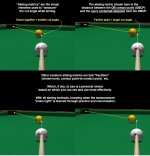A thought or two about aiming "metrics" and how I think they're universally used in pool with or without a conscious method or system. (I think methods and systems are mostly choices of which metric(s) to use.)
One very important metric I didn't mention in the pic below is the visual perception of the amount of CB/OB overlap (without reference to fractions, etc.). This may be the most common metric, especially for "pure feel" aimers - in fact, I suspect it's an unconscious metric in all aiming.
I'm not advocating for or against any particular metric(s), methods or systems, just exploring the nature of aiming generally.
pj
chgo
View attachment 67902
One very important metric I didn't mention in the pic below is the visual perception of the amount of CB/OB overlap (without reference to fractions, etc.). This may be the most common metric, especially for "pure feel" aimers - in fact, I suspect it's an unconscious metric in all aiming.
I'm not advocating for or against any particular metric(s), methods or systems, just exploring the nature of aiming generally.
pj
chgo
View attachment 67902
Attachments
Last edited:
